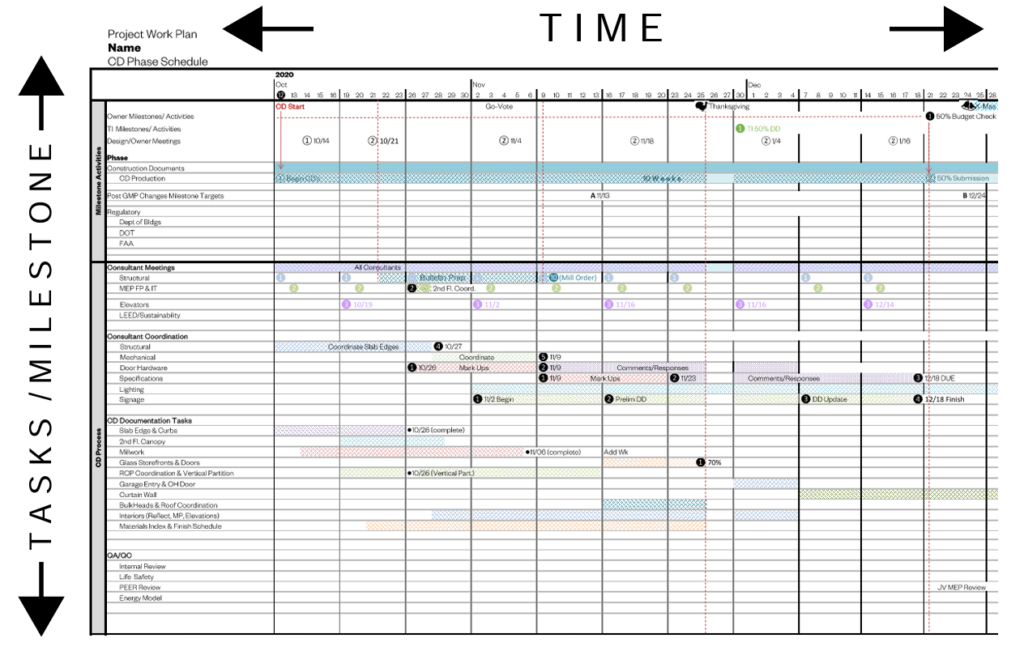
Planning isn’t just a task—it’s the foundation for clarity and direction. In architecture, where creativity meets specificity, planning is essential. It sets clear, specific goals and milestones, providing a structured roadmap to guide every phase of a project. Without a solid plan, even the best intentions can drift off course.
No matter the size or complexity of the project, planning should begin as early as possible. Starting early establishes well-defined priorities and provides a foundation for transforming the big picture into actionable, manageable tasks. This structured approach ensures that each step contributes to the ultimate goal while keeping the team aligned. Moreover, a strong plan empowers teams to anticipate challenges, adapt to changes, and measure progress effectively. In architecture, success isn’t accidental; it results from thoughtful preparation, strategic execution, continuous monitoring, and a thorough closeout process. Effective project planning ensures practical results and drives meaningful progress.
As a Project Architect, you are keenly aware that your role is multifaceted, encompassing project coordination, document production, quality control, and overall execution. While the Project Manager typically leads the planning effort, you play a critical role in shaping the work plan—a key component of the overall project plan—by aligning deliverables with project milestones, coordinating team efforts, and ensuring efficient workflow. By integrating your technical expertise with the project manager’s strategic oversight, you, the Project Architect help translate design intent into actionable steps, maintaining project momentum and ensuring alignment with objectives. Your contributions are essential in bridging the gap between creative vision and practical implementation, ensuring project success.
A well-structured project plan is essential for a successful project, providing clarity, direction, and accountability. While project plans can take various forms, they often begin as a document summarizing key topics that offer the internal team and consultants a clear overview of the project’s objectives, team structure, budget, schedule, and other critical details. Drafting the project plan becomes most effective when essential project details are well understood, typically at the conclusion of the predesign phase. This document also serves as a valuable tool for engaging consultants and is often included in the consultant RFP package. While each office may have its own approach to structuring a project plan, resources such as the American Institute of Architects (AIA) and the book Project Management for Design Professionals by William G. Ramroth Jr. offer valuable frameworks. These generally include:
- Project Description: Provides a comprehensive overview of the project’s fundamental aspects, including scope, size, location, and phasing. It also outlines site-specific opportunities and constraints such as access, zoning regulations, and environmental factors. Additionally, this section captures the owner’s objectives and any unique project requirements, including code details, ensuring alignment with expectations and guiding the design and execution process.
- Program: Define the key functional components of the project, organizing them by building or by specific areas within each building. For example, in a hospital project, this could include patient care areas such as bed floors or towers, diagnostic and treatment (D&T) platforms, public and staff spaces, and essential building services. Clearly identifying these elements ensures alignment with project goals and facilitates efficient design and planning.
- Team Organization: Defines the roles and responsibilities of each team member, including consultants and stakeholders. At this stage, team roles are typically outlined in a diagram identifying key contributors and their responsibilities. This includes the client, architect, and engineers (structural, mechanical, electrical, and plumbing), along with specialists such as curtain wall consultants, landscape architects, and vertical transportation experts. Clearly establishing these roles early on ensures effective collaboration and a well-coordinated design process.
- Scope of Work & Services: Outlines the design, engineering, and estimating services provided by the project team and consultants. This section defines the essential services needed to establish a clear understanding of project scope, which varies based on project requirements. Key components may include Programming, Site Phasing & Design, Building Core & Shell, Interior Design, Regulatory Approvals, early release packages, and separate issuances such as FF&E and signage. Additionally, it may cover Contract Administration and closeout activities to ensure project completion and compliance.
- Budget: Defines the financial framework for the project, detailing cost estimates, funding sources, and resource allocation. It ensures financial feasibility, tracks expenditures, and supports informed decision-making throughout the project lifecycle.
- Schedule: Establishes a timeline of key milestones, deadlines, and deliverables across project phases. It may be integrated into the Scope of Services section, particularly for projects with multiple phases or buildings. The schedule serves as a foundation for developing the Work Plan, ensuring alignment with project objectives and team coordination.
- Meetings: Outline key meetings with the client, user groups, and stakeholders necessary for design and engineering input, approvals, and project progression. This includes consultant coordination meetings to ensure alignment across disciplines.
- Quality Control Measures: Defines the standards and procedures necessary to achieve the desired quality and performance criteria. This section is crucial in setting clear expectations for the entire design team. It ensures consistency in drawings, coordination across disciplines, and alignment of design and documentation with client requirements and expectations. A well-defined quality control plan enhances efficiency, reduces errors, and maintains project integrity from concept to completion.
- BIM Execution: Establishes documentation standards within BIM, defining requirements for Level of Development (LOD), publishing protocols, and software expectations for each consultant—just to name a few. The project plan highlights key BIM priorities and may include the full BIM execution plan as an appendix for detailed reference.
- Consultant Deliverables: Clearly defines expectations and responsibilities for design consultants. While the Project Plan may address this broadly, it is crucial to establish a detailed understanding of each consultant’s role in coordination, documentation, and deliverables. Misalignment can lead to inefficiencies and gaps in scope. The Project Architect must be well-versed in these expectations to ensure the architectural team focuses on its core responsibilities without inadvertently assuming tasks designated to consultants. This section will be explored further in a future discussion.
By incorporating these elements, the project plan keeps everyone on the same page, helping to make informed decisions and move the project forward smoothly. Other important topics might include sustainability goals and LEED certification requirements, the types and level of detail expected for mock-ups, and how deliverables evolve across project phases. The Project Architect, alongside the Project Manager, is central to pulling all these details together in the work plan. They ensure expectations are clear, the team is aligned, and the process runs efficiently, keeping the project moving forward with a shared understanding among all stakeholders.
The Work Plan is what keeps the project moving in the right direction, laying out the steps for coordination, deliverables, and decision-making in a practical, actionable way. As a Project Architect, you work closely with the Project Manager to shape and refine the Work Plan, making sure everyone is on the same page, roles are clear, and the team stays focused on the bigger picture. Without a solid Work Plan, teams can quickly run into miscommunication, inefficiencies, and delays that put the project’s success at risk.
Several tools can help Project Architects and Project Managers document and manage the work plan efficiently and visually. Common options include:
- Microsoft Project: A widely used project management tool offering scheduling, resource management, and reporting features.
- ProjectManager: Provides intuitive dashboards and real-time tracking for better project visibility.
- Smartsheet: A flexible, spreadsheet-based platform with automation and collaboration tools.
- Deltek: Designed for architecture and engineering firms, offering project planning, resource management, and financial tracking.
- Microsoft Excel: A flexible tool widely used for tracking and customizing work plans. It allows teams to design their plans to fit specific project needs, offering full control over formatting and organization. However, updating the plan in response to changes can be more cumbersome compared to dedicated project management software.
- Or by Hand!: Hand-sketched work plans are a great option when flexibility and quick iteration are needed. They allow for a more intuitive and creative approach, making it easier to visualize complex workflows and adjust on the fly.
Choosing the right tool comes down to your preferences and the level of detail required. Each office may already have a preferred system in place, so you may need to adapt or suggest an alternative. As mentioned before, integrating these tools improves coordination, communication, and overall efficiency. Your work plan should be structured in a way that makes sense for you and the team—Gantt charts are great for tracking long-term tasks and milestones, while simple task lists work well for managing immediate, weekly priorities that tie back to the broader plan. Regardless of the format, the goal is to create a structured roadmap of tasks and milestones over a weekly, monthly, or quarterly timeline. Typically, tasks are listed vertically on the left side of the page, while the timeline runs horizontally, with markers indicating key milestones along the way.
Tasks and milestones should be tailored to the specific needs of the project and its phase. Common tasks include:
- Schedule: Typically outlined in days, weeks, or months, depending on the project scale. For example, the Schematic Design phase might span 14 weeks, with milestones marking key progress points along the way.
- Meetings: Regular touchpoints with the internal team, client, consultants, and regulatory agencies help ensure alignment throughout the project. The frequency and format of these meetings will depend on the project’s complexity and phase.
- Process: This section typically includes Analysis, Design, Coordination & Production, and Quality Control. Each subsection outlines the key tasks required for completion. For example, Analysis may involve research, programming and planning, sustainability considerations, and compliance with codes and regulations.
- Notes: Typically found at the bottom of your work plan, this section provides additional details and clarifications on requirements. It allows you to expand on tasks and milestones that don’t fit neatly within the main schedule, ensuring critical information is documented without cluttering the core timeline.

The importance of work planning can’t be understated as it ensures alignment, accountability, and efficiency throughout a project. A well-structured work plan clarifies roles, sets realistic timelines, and mitigates risks, preventing unnecessary delays or miscommunication. It serves as a guidepost for the entire team, helping to track progress, adapt to changes, and meet deliverables effectively. For a Project Architect, it’s not just about planning tasks—it’s about setting the framework for collaboration and execution. When done right, work planning transforms a vision into a tangible, well-managed process that leads to successful project completion.
be the ONE